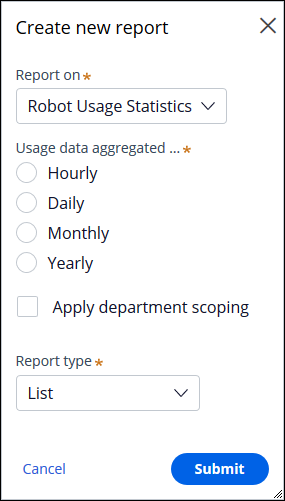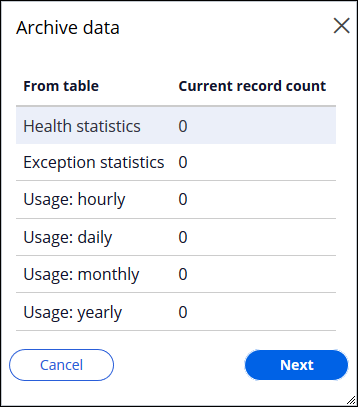
Reports in Pega Robot Manager
Pega Robot Manager reports overview
Pega Robot Manager™ comes with many reports configured out of the box. These reports allow you to monitor in real-time the efficiency and success of both attended and unattended robotic automations. For example, these reports allow you to view how often an automation is invoked and how long it takes to complete its task on average over the last year, or you can run a report to view a list of exceptions in the last day of operation. There are many other reports providing insight into robot usage, operational metrics, and health statistics, among others.
Because this functionality is built on top of the standard reporting in Pega Platform™, users can create new reports in the same manner. Custom reports can be generated based on the specific metrics and filtering conditions that the work manager wishes to view.
Pega Robot Manager report categories
All of the standard reports provided in Pega Platform are available in Pega Robot Manager. Pega Robot Manager also adds the following three new report categories. You can view the reports in these categories as is or use the report categories as a starting point for custom reports tailored to your organization’s need. Users with the ReportAdmin, ReportWriter, and ReportUser roles can view these reports.
| Report Category | Information the reports provide |
|---|---|
| Robotics licensing | Robot log-ins and sessions. The total log-ins, first and last session, and total robots are all tracked in this report category. Reports can be viewed at the daily, monthly, or yearly level. |
| Robotics operational | Operational statistics about department usage and exceptions. The reports track both the unattended and attended usage by department as well as any exceptions that may have occurred. |
| Robotics usage | Robot usage, invocations, and duration. The reports focus on how often and how long robots are running. This includes information on the idle time of robots as well as the number of invocations and total duration. Reports can be viewed at the hourly, daily, monthly, or yearly level. |
Data collection in Pega Robot Manager
Users with ReportAdmin or ReportWriter roles can also create and edit custom reports by using one of three new data sources: Health Statistics, Exception Statistics, and Robot Usage Statistics. Pega Robot Runtime collects this data locally and sends it to Pega Robot Manager every hour. If the runtime goes down before sending the data, it will send any pending data the next time it is active.
Health Statistics
Health Statistics allow you to monitor the behavior of your robots and key data about their operation state.
Columns available for use in reports include Package Loaded Date Time, Runtime Login Date Time, Runtime Start Date Time, Runtime Version, and User ID.
Exception Statistics
Exception statistics provide you with a tracking method to detect when something goes wrong in your robotic automation. When an exception occurs, Pega Robot Manager records the DateTime, Message, Stack Trace, and Type of the exception. These statistics can be included in a report for monitoring.
Robot Usage Statistics
Robot usage statistics capture data about how your robots are used. This data includes information on total invocations, total duration, and average duration of robotic processes.
When creating a report on usage statistics, you can choose to use statistics from the last hour, day, month, or year. You can also choose whether to limit this to just your department.
By default, usage intervals collection settings are inherited from the built-on (parent) application. If the built-on application also inherits the settings from its parent application, the application stack follows until the dependency resolves. If an application does not contain an instance of the settings, Pega Robot Manager uses default settings. Pega Robot Manager always collects the data half-hourly, but you can determine how the data is aggregated and stored. You can choose to ingest data into the hourly, daily, monthly, and yearly tables. You choose which table to source your data when creating reports.
Archival and purging of data
You may want to exclude information from being used in your report. For example, your company reorganized departments, and you do not wish for old data to be displayed in your report. In this scenario, you can archive your data. Archiving data removes the data from the table used for reporting and moves the data into a separate archive table.
Archived data is stored in the following classes:
| Data | Archive Class |
|---|---|
| Exception Statistics | Data-Robotic-OperationalStatistics-Exception-Archive |
| Health Statistics | Data-Robotic-OperationalStatistics-Health-Archive |
| Hourly Usage Statistics | Data-Robotic-OperationalStatistics-Usage-Hourly-Archive |
| Daily Usage Statistics | Data-Robotic-OperationalStatistics-Usage-Daily-Archive |
| Monthly Usage Statistics | Data-Robotic-OperationalStatistics-Usage-Monthly-Archive |
| Yearly Usage Statistics | Data-Robotic-OperationalStatistics-Usage-Yearly-Archive |
If your organization no longer needs to maintain data after archival, you can purge data entirely and remove the data permanently. Only users with the role ReportAdmin can archive or purge data.
This Topic is available in the following Module:
If you are having problems with your training, please review the Pega Academy Support FAQs.
Want to help us improve this content?


